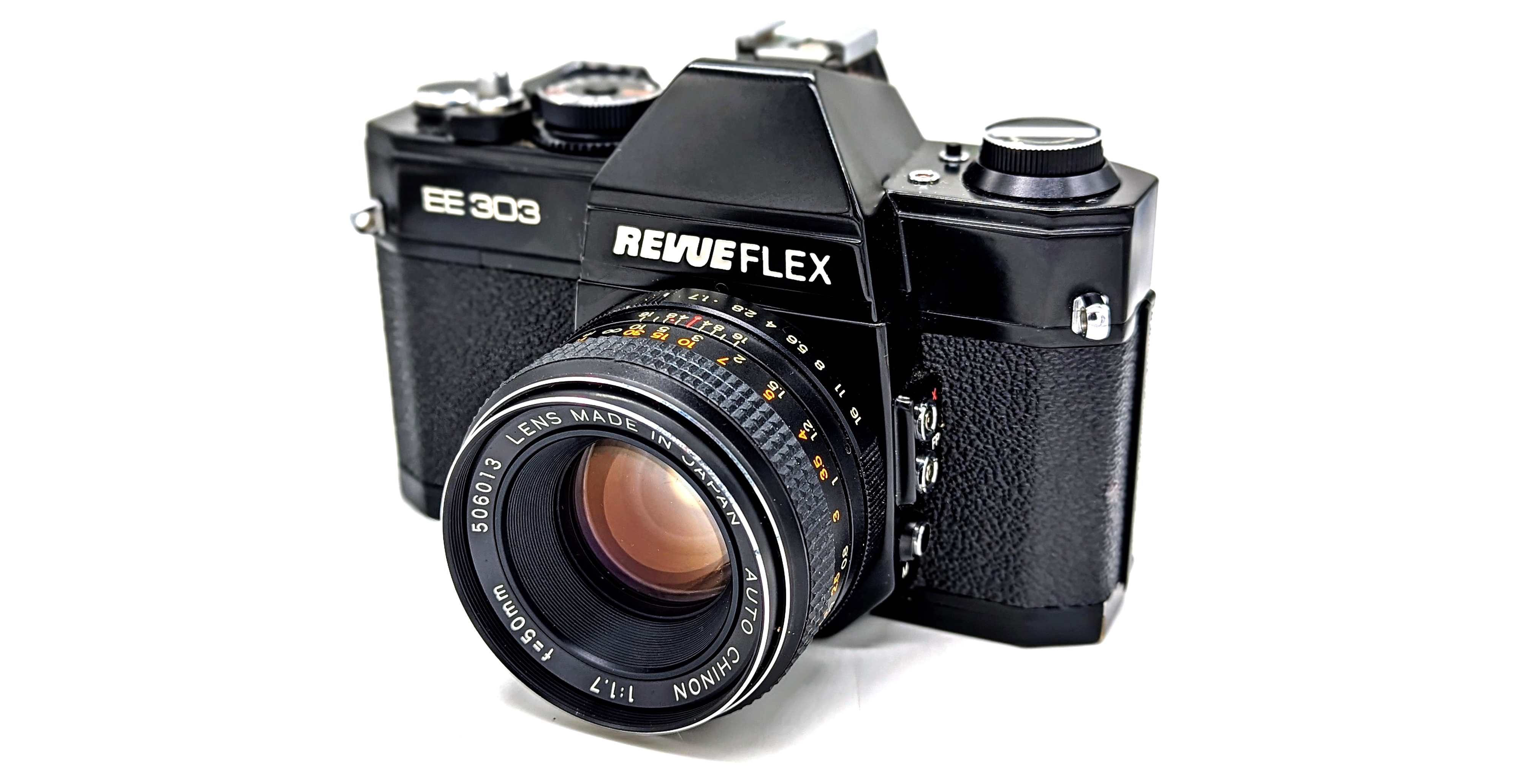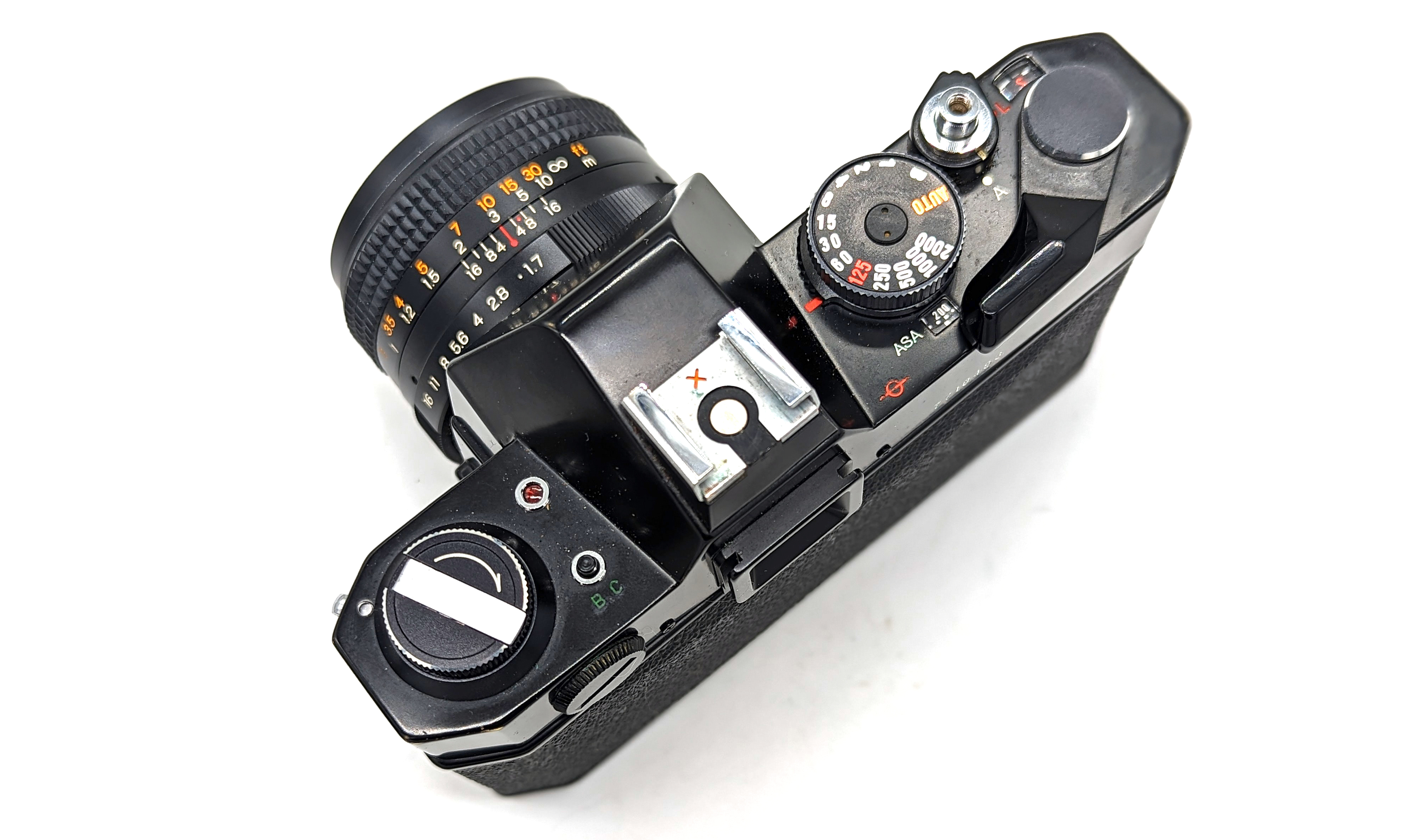
Introduced to market during 1977, the Revueflex EE 303 (a rebadged “Hi Lite ECL” for a West Germany-based retailer named Foto-Quelle) was Cosina’s most advanced M42 SLR and a follow-up to its 1972 Hi Lite EC model. The Hi Lite ECL’s primary distinguishing feature included the employment of a primitive autoexposure system that works all auto-diaphragm M42 lenses. In most respects, the Hi Lite ECL mirrors the functionality of similar products, like the Hi Lite EC and the contemporary Chinon CE-II (1976). The Hi Lite ECL’s incremental improvements over the original Hi Lite EC included: (1) being somewhat lighter; (2) increasing the max ASA for the light meter from 1600 to 3200; and (3) adding an exposure lock button. Unlike the Hi Lite EC and the CE-II, which are fairly plentiful on the used market today, both the Hi Lite ECL and Revueflex EE 303 are a little hard to find today, suggesting that neither sold particularly well.
While I remain convinced that the 1978 Chinon CE-3 (aka the “Revueflex AC1”) is, overall, the most advanced and versatile M42 camera body of the film era, certain Cosina and Chinon cameras with the same or similar autoexposure system before it could achieve a slightly higher top shutter speed of 1/2000, which comes in handy from time to time. Given the alternatives, is there a case for the EE 303 / Hi Lite ECL to be your daily M42 platform? Let’s take a look.

Specifications
| Lens Mount | M42 |
| Shutter | Copal E-394 (Electronic Metal Vertical) |
| Shutter Speeds | 2 sec. – 1/2000 (Continuously Variable) |
| Viewfinder | 0.9x Mag. / 95% Coverage (with 55mm lens) |
| Focusing Screen | Fresnel Lens and Micro-Prism |
| X-Sync | 1/125 |
| Battery | 1 x S28PX or A544 (6V) |
| Weight | 730g |
| ASA Range | 25-3200 |

Operation
The EE 303 is a well-built, all-metal, and sturdy camera, certainly a member of the upper-range of consumer 35mm film SLRs from the mid-1970s. It has quality industrial and ergonomic design, including the layout and design of the various switches and buttons. It was a fairly expensive camera in its day and was sold with a number of standard lenses, including but not limited to the Auto Revuenon 55mm f/1.4 or 55mm f/1.7 (which were also sold at the time under a variety of different names). The Chinon 50mm f/1.7 pictured here was not sold with it.
Aperture-Priority Autoexposure System: The primary draw of certain Chinon and Cosina models from the 1970s was the employment of a primitive autoexposure system that could work with any auto-diaphragm M42 lens, regardless of manufacturer. Essentially, the way it works is that a half-press of the shutter button simultaneously stops down the lens to the selected aperture, meters the scene, and automatically selects a shutter speed corresponding to the aperture. This preview ability temporarily darkens the viewfinder as the lens stops down. With the aid of the electronically-controlled shutter, a full press then trips the shutter. This saves time and effort compared to prior generations of M42 cameras that required a two-step manual stop down procedure.
Although I had assumed that the Cosina autoexposure system worked pretty much the same way as the Chinon CE-II and CE-3, it unfortunately does not. Unlike the Chinons, the Hi Lite ECL shutter button does not contain a spring that will push the lens back to wide open after you release the half-press of the shutter button. In other words, a half-press will stop down the lens to the taking aperture, but releasing the button does not re-open the aperture to wide-open. Instead, you must use an external button at the 7 o’clock position around the lens to re-open the aperture and reset the metering. The half-press allows you to change the aperture, which automatically re-meters the scene and adjusts the shutter speed accordingly (although the viewfinder will get darker and darker as you stop down). For me, the Chinon spring-loaded shutter button system is better, faster, and more intuitive.
Exposure Lock: Although the EE 303 does have an exposure lock function, it is also not as practical as the system used on the CE-3. To use it, you must first half-press the shutter to get a meter reading and then hold in a little button on the right side of the lens. However, as soon as you release the button, the AE-L disengages. The CE-3’s AE-L system locks the exposure with a press-in button that does not require continuous pressing.
Manual Metering Mode: The EE 303 also a manual metering mode. For a given aperture, you can select any shutter speed. When you meter, the viewfinder will tell you what actual shutter speed should be be chosen for the selected aperture.
Shutter: The EE 303 uses a standard Copal electronically-controlled metal shutter with continuously-variable shutter speeds from 1 second to 1/2000. The shutter noise is about average for a 1970s SLR. Although the shutter is battery-dependent, there is a manual backup speed of 1/125.
Viewfinder: The EE 303 does have a fairly nice viewfinder and focusing screen for the era, both of which seem to be carried over from the original Hi Lite EC. The match-needle shutter speeds are displayed in the left side of the viewfinder from 1 – 1/2000 with red zones above and below the scale for over and under exposure. The focusing screen is a fresnel type with a micro-prism center spot. The 0.9x magnification and 95% frame coverage are outstanding specs until you realize that they are for a 55mm lens. With a standard 50mm lens, you would have less of both.
Battery: Like some other 1970s cameras, the EE 303 uses a 6V 4xSR44-type battery that powers the center-weighted TTL light meter and controls the shutter. The silver oxide version is a S28PX and the alkaline is an A544. The battery loads into the top back of the body, rather than through the bottom. There is a neat battery check button on the top right of camera that illuminates a small adjacent orange light to show whether the battery has sufficient power.
Film Load Indicator: An interesting feature that I have not seen on too many SLRs is the EE 303’s “film load indicator.” If there is film loaded in the camera, a little window northwest of the rewind crank will display red. If there is no film loaded, no color will be shown.
Flash: The EE 303 does not have any sophisticated flash capability, having just a single contact on the shoe for electronic flashes. To the side of the lens, there are terminals for a X-sync and FP (bulbs) if you are using a flash with a cable connection. The flash sync of 1/125 is par for the course for the era.
Other Features: The EE 303 has a standard set of more mundane features, such as ASA settings from 25 to 3200, the provision for a regular cable release, a shutter button lock switch (which does not lock into place, just slides back and forth), a eyepiece light trap that prevents stray light from entering the viewfinder during longer exposures, and a self-timer of 10 seconds.
Proprietary Accessories: Other than a case, none really of note.

Conclusion
While seemingly quite rare these days on the used market, the EE 303 is a perfectly nice, high-quality M42 camera. Along with the variety of standard features, it has a nice viewfinder and a fast top shutter speed. However, because the main draw of a camera in this class is its aperture-priority autoexposure function with all auto-diaphragm M42 lenses, the Chinon CE-II and CE-3 system is preferable as it does not require an additional step to re-open the aperture for the purposes of metering and focusing. Despite not having a 1/2000 top speed, the CE-3 has a variety of advantages over the EE 303, like a split screen focusing aid, the provision for a motor drive, and an easier-to-use AE-L function. If none of that matters to you, the EE 303 / Hi Lite ECL is overall a nice platform for the use of the world of M42 lenses.